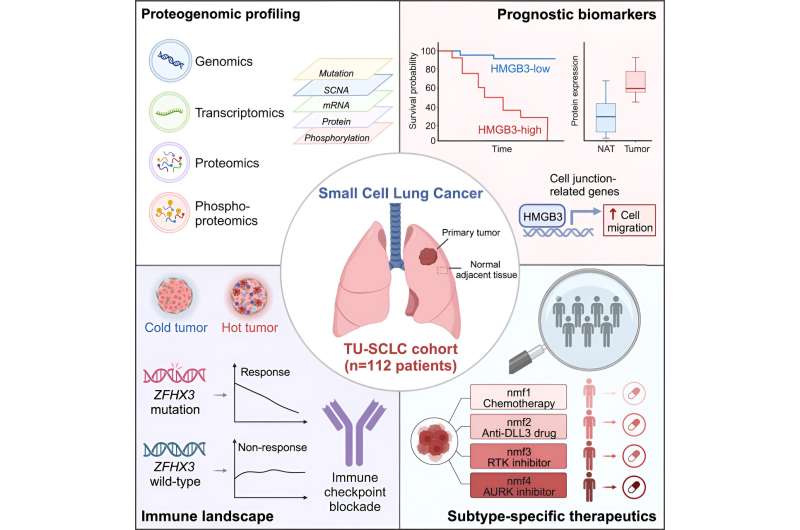
Researchers in China have reported the primary large-scale examine characterizing the proteomics and phosphoproteomics of small cell lung most cancers (SCLC) scientific cohorts, offering a complete image of the proteogenomics panorama of SCLC.
The workforce is led by Prof. Zhang Peng from Shanghai Pulmonary Hospital of the Tongji College, Prof. Zhou Hu from Shanghai Institute of Materia Medica of the Chinese language Academy of Sciences (CAS), and Prof. Gao Daming and Prof. Ji Hongbin from the Heart for Excellence in Molecular Cell Science, Shanghai Institute of Biochemistry and Cell Biology of CAS.
This examine, printed in Cell, reveals the molecular options of SCLC and proposed new molecular subtypes and focused customized remedy methods, and laying a strong basis for a greater understanding of the underlying mechanisms and enchancment of scientific therapeutic methods for SCLC.
Lung most cancers is the commonest malignant tumor worldwide. SCLC accounts for about 15% of all lung most cancers instances, and it’s characterised by speedy proliferation, robust metastatic potential, excessive remedy resistance, and the best malignancy and fatality fee with a five-year survival fee of solely 5%. Nonetheless, the progress within the remedy of SCLC has been gradual, and viable therapeutic targets and precision therapies that considerably enhance survival charges have but to be recognized.
On this examine, the researchers collected tumor and matched adjoining tissue samples from 112 Chinese language SCLC sufferers who underwent surgical resection, and performed integrative multi-omics analyses together with entire exome sequencing, transcriptomics, proteomics, and phosphoproteomics.
The researchers first recognized TP53 and RB1 as the most important gene alterations in SCLC by means of somatic mutations and replica quantity losses. It was discovered that the gene mutation frequency of ZFHX3 was larger within the Chinese language populations in comparison with Western populations. The gene mutations of TP53, FAT1 and GNAS, have been proven to have an effect on their very own expressions, and FAT1 gene mutations might promote the incidence and improvement of SCLC by selling cell EMT phenotype.
Copy quantity variations have been proven to have cis and trans regulatory results on mRNA and protein expression, with RB1 loss displaying a big trans impact on the protein degree however a minor impact on mRNA. Chromosome 5q loss regulated the expression of proteins associated to DNA synthesis, DNA harm restore, and cell cycle by means of trans results, which can be an necessary mechanism underlying SCLC improvement.
By evaluating the proteomic traits of tumor tissues and matched adjoining tissues, the researchers then recognized a collection of proteins, phosphorylation websites and kinases (CHEK1, ATR, ATM, CDK2, GSK3A) which are carefully related to the incidence and improvement of SCLC. HMGB3 and CASP10 have been recognized as considerably related to prognosis. HMGB3 was extremely expressed in tumors and was related to worse prognosis. CASP10 had decrease expression and was additionally correlated with poorer prognosis.
Immunohistochemical evaluation in an unbiased scientific cohort confirmed the correlation between HMGB3 and CASP10 expression and prognosis, suggesting their potential worth as prognostic indicators. Additional organic experiments confirmed that HMGB3 might promote cell migration in SCLC by means of transcriptional regulation of cell junction-related gene expression.
Apart from, the researchers immunotyped SCLC tumors based mostly on the degrees of immune cell infiltration. Most SCLC tumors have been categorised as chilly tumors with poor prognosis. Solely a minority belonged to the new tumor subtype, which confirmed activation of immune-related pathways akin to interferon-gamma pathway, antigen presentation, and upregulation of immune checkpoint molecules (akin to CTLA4, PD-L1, PD-1), suggesting potential advantages from immunotherapy.
ZFHX3 mutations have been considerably enriched within the sizzling tumor subtype and have been carefully related to elevated immune cell infiltration. Sufferers with ZFHX3 mutations confirmed higher remedy response, indicating that ZFHX3 mutations may very well be a biomarker for immunotherapy in SCLC and offering necessary clues for extra exact tumor immunotherapy.
Lastly, 107 SCLC tumor samples have been divided into 4 distinct subtypes (nmf1~nmf4). Every subtype confirmed particular remedy vulnerabilities. For instance, the nmf2 subtype confirmed excessive expression of DLL3, suggesting a possible higher response to anti-DLL3 therapies like Tarlatamab, a bispecific antibody. The nmf3 subtype exhibited traits of elevated RTK signaling, indicating potential advantages from therapies with RTK inhibitors akin to Anlotinib. The invention of those subtypes and their corresponding options will help in guiding the scientific remedy choice for SCLC.
The researchers additionally established large-scale patient-derived tumor xenograft (PDX) fashions and cell line-derived xenograft (CDX) fashions of SCLC, and performed genomic and proteomic integration evaluation on them to validate the focused remedy methods based mostly on the molecular subtyping of scientific samples.
In abstract, these findings present a theoretical foundation for the understanding of the pathogenic mechanisms, prognosis prediction, molecular subtyping, and customized remedy of SCLC. The high-quality knowledge generated will assist each primary and scientific analysis within the area of SCLC.
Extra data:
Qian Liu et al, Proteogenomic characterization of small cell lung most cancers identifies organic insights and subtype-specific therapeutic methods, Cell (2024). DOI: 10.1016/j.cell.2023.12.004
Cell
Chinese language Academy of Sciences
Quotation:
Proteogenomics reveal prognostic markers of small cell lung most cancers, advance improvement of precision therapies (2024, February 27)
retrieved 27 February 2024
from
This doc is topic to copyright. Other than any honest dealing for the aim of personal examine or analysis, no
half could also be reproduced with out the written permission. The content material is offered for data functions solely.







